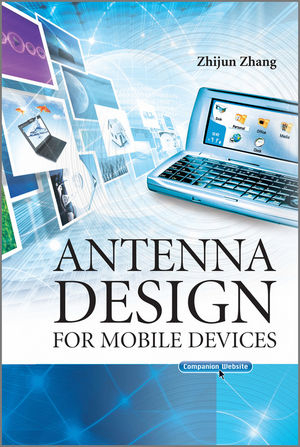
Antenna Design for Mobile Devices
Wiley-Blackwell (Verlag)
978-0-470-82446-7 (ISBN)
- Titel erscheint in neuer Auflage
- Artikel merken
Written by an antenna engineer turned professor who has worked at Apple, Nokia and Amphenol,
Antenna Design for Mobile Devicesis a comprehensive guide for fresh and intermediate engineers involved in antenna design. The book instructs readers through all aspects of real world antenna designs, which includes how to make a stable antenna fixture, designing various types of antennas, designing an antenna with good manufacturability, using various matching technique to improve antenna performance, setting up production measurement for mass manufacturing, and making antenna SAR and HAC compliant. Most popular antenna categories, such as internal PIFA, integral IFA, internal folded monopole, ceramic antennas, stubby antennas and whip stubby antennas, are introduced in the book. The book focuses on the basic principle of each kind of antenna and emphasizes on key parameters of antenna optimization. Complimentary matching software, which accompanies the book, is provided so readers can practice various antenna matching technique and design matching circuits for real projects.
A one–stop design reference containing all an engineer needs when designing antennas
Accessible to readers of many levels, from introductory to specialist
Presents shortcuts for engineers who lack antenna knowledge but need no–hassle techniques for designing simple antennas
Contains hands–on knowledge not available in other books
Written by a practicing expert who has hired and trained numerous engineers
Incorporates the various techniques used by pure–play antenna firms, established mobile device brands, and new entrants to the mobile space
Comes with antenna matching software written by the author, which can be used for practice and real–world projects
Presentation slides with lecture notes available for instructor use
This book is targeted at practicing antenna engineers, particularly those focusing on mobile devices, as well as researchers and academics looking to keep up with this quick–changing field. Engineering managers will find it to be a helpful guide for teaching new hires, while new hires, by using the book themselves, will be able to quickly gain expert–level proficiencies. The book is also suitable for wireless network equipment engineers, who desire a stronger sense of antenna principles, as well as electronic engineering students studying electromagnetics. Readers should possess a basic undergraduate–level understanding of electromagnetic theory.
Companion website for the book: http://www.wiley.com/go/zhangantenna
Zhijun Zhang is a Professor of Electronic Engineering at Tsinghua University in Beijing, China. He holds rich industry experience, with senior positions as an antenna development engineer at Amphenol T&M Antennas, Nokia, and Apple, giving him a perspective of design practices at a number different players in the mobile segment. Prior to Tsinghua, his academic career included a postdoctoral fellowship and research professorship at the University of Utah, and a position as Assistant Researcher at the University of Hawaii, where he continues to serve as Adjunct Professor. Zhang earned a B.S. in Microwave Engineering and an M.S. in Applied Physics at the University of Electronic Science and Technology of China, Chengdu. He holds a PhD in Electronic Engineering from Tsinghua University.
Preface xi
Acknowledgments xiii
About the Author xv
Abbreviations xvii
1 Introduction 1
1.1 The Evolution of Mobile Antennas 3
1.2 How to Quantitatively Evaluate an Antenna 8
1.3 The Limits of Antenna Designs 11
1.4 The Trade–Offs in Antenna Designs 13
1.5 Mobile Communication and Band Allocations 15
References 17
2 Antenna Matching 19
2.1 The Smith Chart 20
2.2 Single Band Matching 23
2.2.1 Matching with Lumped Elements 25
2.2.2 Different Ways to Accomplish a Single Band Matching 28
2.2.3 Matching with Both Transmission Line and Lumped Elements 31
2.2.4 Bandwidth Consideration 35
2.3 Dual Band Matching 43
2.4 Reconfigurable Matching 48
2.4.1 Reconfigurable Matching – Varactor–Based 49
2.4.2 Reconfigurable Matching – Switch–Based 52
References 57
3 External Antenna 59
3.1 Stubby Antennas 61
3.1.1 Single Band Helix Stubby Antenna 61
3.1.2 Multi–Band Helix Stubby Antenna 81
3.1.3 Ultra–Wide Band Stubby Antenna 105
3.2 Whip–Stubby (Retractable) Antenna 115
3.2.1 Decoupled Whip–Stubby Antenna 117
3.2.2 Semi–Decoupled Whip–Stubby Antenna 119
3.3 Meander Line Stubby Antenna 125
3.4 Effect of Ground Plane 129
References 136
4 Internal Antenna 139
4.1 Inverted–F Antenna (IFA) 141
4.2 Planar Inverted–F Antenna (PIFA) 147
4.2.1 Single Band PIFA 147
4.2.2 Multi–Band PIFA Antenna with Slits 150
4.2.3 Multi–Band PIFA with Separate Branches 159
4.2.4 Multi–Band PIFA with Parasitic Element 160
4.2.5 Manufacturing PIFA Antenna 161
4.3 Folded Monopole Antenna 165
4.4 Loop Antenna 170
4.5 Ceramic Antenna 175
4.5.1 Monopole–Type Ceramic Antenna 176
4.5.2 IFA–Type Ceramic Antenna 180
4.5.3 Loop–Type Ceramic Antenna 181
4.6 Multi–Port Internal Antenna Module 182
References 187
5 Antenna Measurement 189
5.1 Passive Antenna Measurement 189
5.1.1 Measurement on a Vector Network Analyzer 189
5.1.2 Fixture 195
5.1.3 Passive Chamber Measurement 207
5.2 Active Antenna (OTA) Measurement 215
5.2.1 EIRP, ERP, and TRP 216
5.2.2 EIS and TIS 220
5.2.3 Sensitivity Degradation Due to Interference 223
5.3 Antenna Measurements in the Production Line 226
References 236
6 Regulations Related to Antenna Engineers 239
6.1 Specific Absorption Rate (SAR) 239
6.1.1 Definition and Measurement Method of SAR 240
6.1.2 SAR Limits in the United States and Europe 247
6.1.3 Controlling SAR 249
6.2 Hearing Aid Compatibility (HAC) 259
6.2.1 HAC Measurement 260
6.2.2 HAC Specification in the United States 263
6.3 Electromagnetic Compatibility (EMC) 268
References 269
Appendix: User Manual for ZJ—Antenna—Matching Software 271
Index 279
| Reihe/Serie | Wiley - IEEE |
|---|---|
| Verlagsort | Hoboken |
| Sprache | englisch |
| Maße | 200 x 248 mm |
| Gewicht | 682 g |
| Themenwelt | Technik ► Elektrotechnik / Energietechnik |
| Technik ► Nachrichtentechnik | |
| ISBN-10 | 0-470-82446-8 / 0470824468 |
| ISBN-13 | 978-0-470-82446-7 / 9780470824467 |
| Zustand | Neuware |
| Haben Sie eine Frage zum Produkt? |
aus dem Bereich



